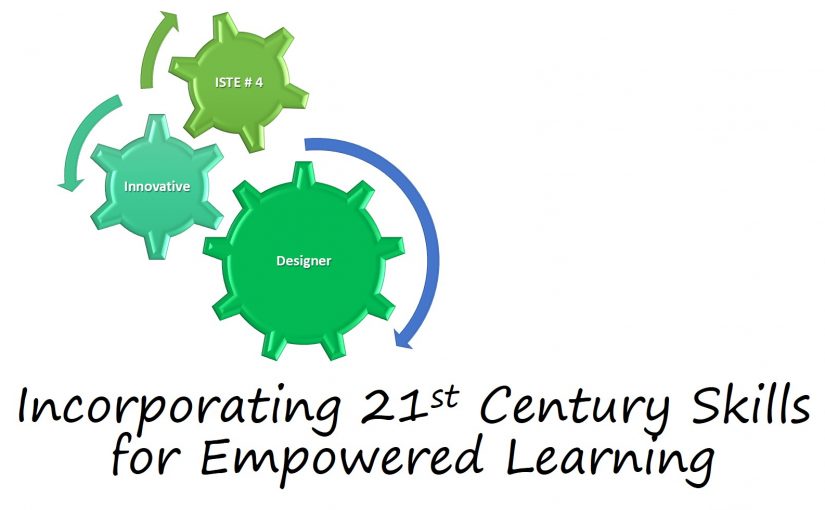Whenever I think of the word “innovation,” I am reminded of the bear, honey, and powerline story. If you are not familiar with this story, I’ll offer a brief synopsis here, though there are other detailed versions available.
Employees of a powerline company met to brainstorm the issue of snow and ice accumulation on power lines which would down the lines in winter months. Despite formal, morning-long brainstorming, the session yielded little results. Frustrated, the team decided to take a short break. While on break, a few of the team members began to talk over coffee where one team member reminisced about how he got chased by a bear while out servicing the lines. After a good laugh, other team members jokingly suggested that they get bears to remove the snow/ice by placing honey pots on top of the powerlines. Continuing the joke, one team member suggested that they use helicopters to place the pots. This idea was put to rest as another team member mentioned that the vibrations from the helicopters would scare the bears. Suddenly they realized they had a great solution on their hands, the company could use helicopters to remove the snow/ice through the force and vibrations caused by the helicopter blades. Because of this impromptu brainstorming session, using helicopters to remove snow and ice from powerlines is a common practice today.
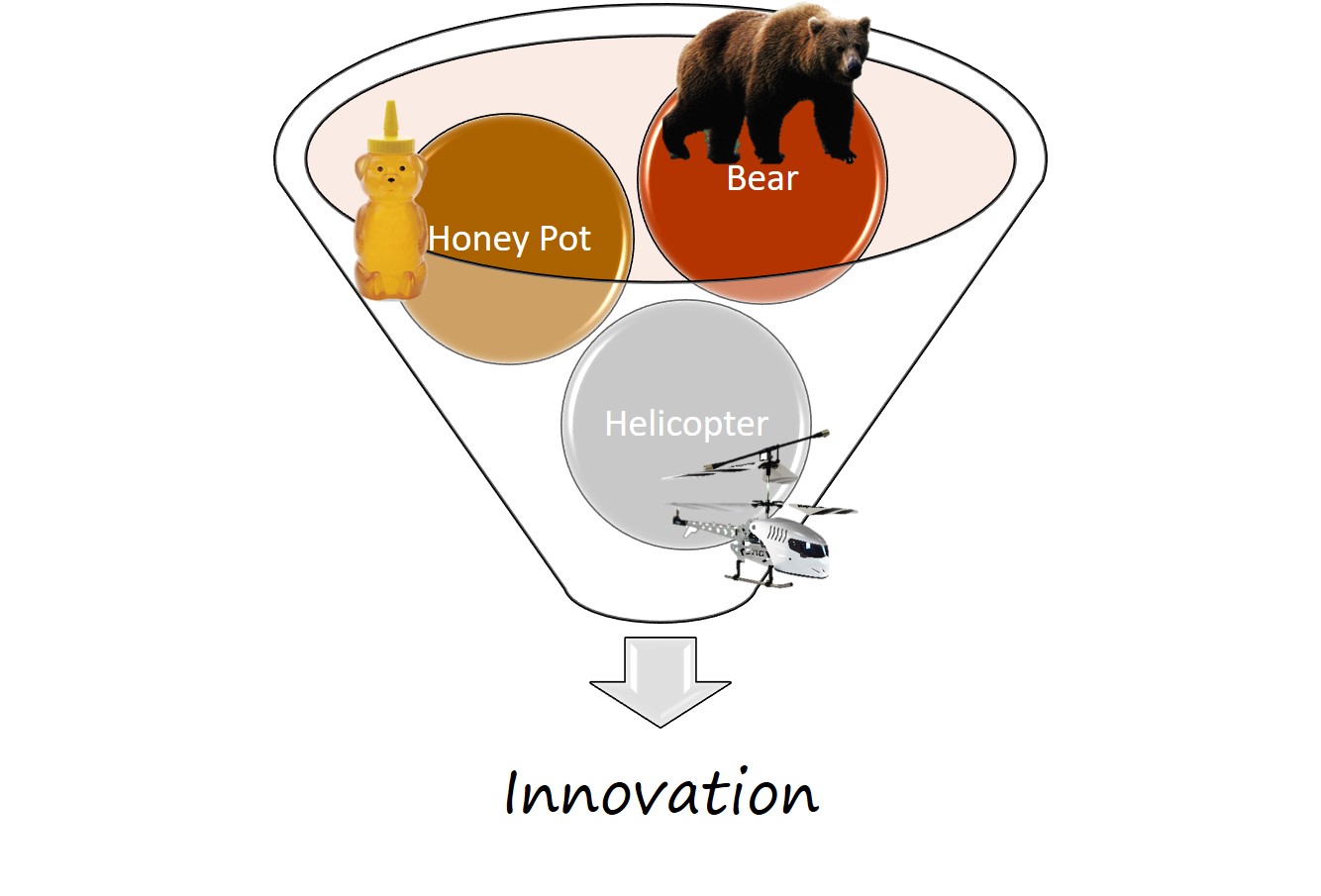
I like this story because it dispels the misconception that to be innovative you must create something new, like a product or a service. Instead, innovation can be a way to problem solve. Much like the process that unfolded in the bear story, students should be encouraged to problem solve in creative ways. By offering students opportunity to seek, identify, and apply information, they are building cognitive flexibility, a 21st century skill, (Kuo et. al., 2014). Cognitive flexibility encourages the development of creativity needed for innovation, a concept that involves the ISTE innovative designer standard where “students use a variety of technologies within a design process to identify and solve problems by creating new, useful or imaginative solutions,” (ISTE, 2017).
So then, how do you get students to begin thinking less about the “correct answer” and more “bears, honey, and helicopters” for innovation? This can be particularly difficult when students historically have been offered a “right” and “wrong” depiction of problems. Students can be “eased” into creativity through scaffolding using the systematic thinking concept of the creative problem solving model, (Kuo et. al., 2014). A summary of the model can be found in figure 1.2 below.
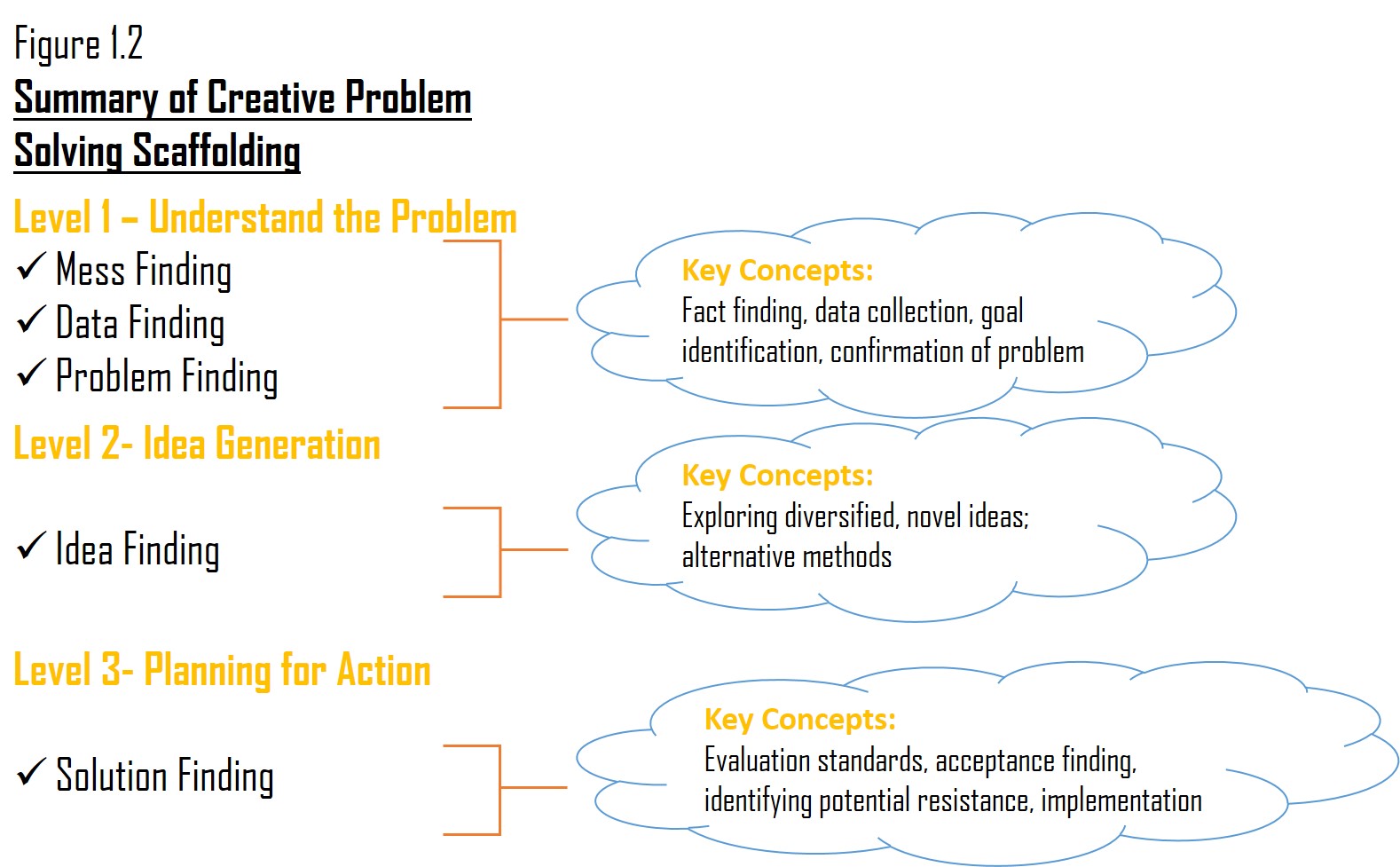
The creative problem solving model transitions students between understanding a problem, generating ideas about the problem, and finding solutions to that problem, (Kuo et. al., 2014). The students evolve their thinking from identification to more complex thinking, ultimately evoking creativity and innovation.
While the creative problem solving model can be used to build cognition through various problem-solving steps, problem-based learning (PBL) can help format the classroom to help achieve self-directed learning. An instructor can start with any question-type from the creative problem solving model and allow students to work through that question with PBL. The general process for designing a problem-based classroom is demonstrated in figure 1.3 below.
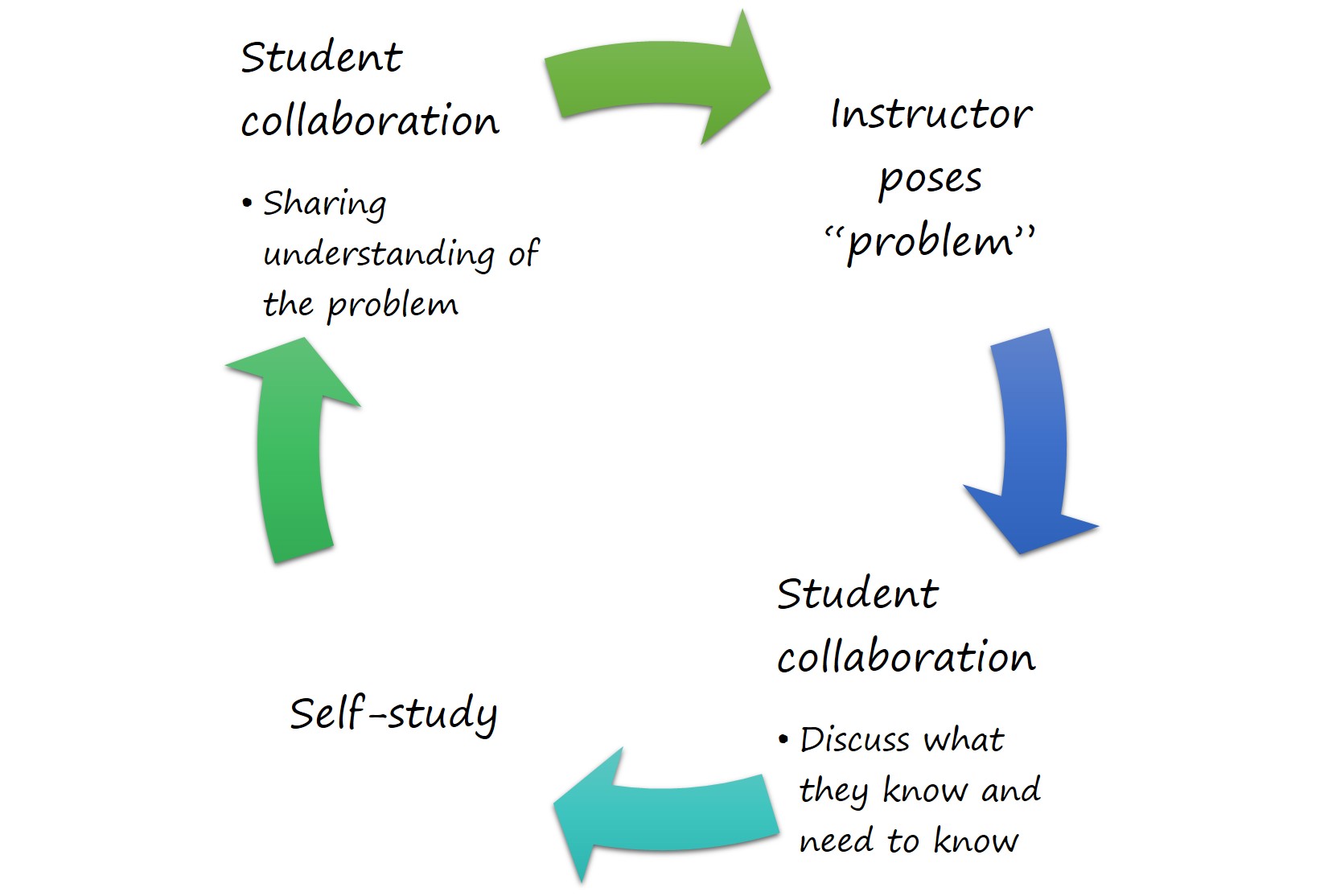
According to the National Academies Press, a PBL activity focuses on student-centered learning where the instructor is a facilitator or guide and the students work together to gather information, then generate ideas to solve the problem. The problem itself becomes the tool to obtain knowledge and develop problem solving skills, (National Academies Press, 2011). PBL is not without its faults, in using PBL, students have slightly lower content knowledge than in the traditional classroom and students in a group may not share the same level of cognition, (National Academies Press, 2011). Despite this, students engaging in PBL have a higher retention of content than in traditional classrooms, are better able to apply their knowledge, and have a deeper understanding of the content, (National Academies Press, 2011).
Putting the Theory into Practice: The Investigation
Several of the classes that I teach are content-based/coverage-based classes. These classes are designed to be foundational, meant to prepare students for higher level or more in-depth, application-based classes later on. As I was thinking about problem-based learning, I started wondering: “how can we fully expect students to become problem-solvers and apply content in more advanced classes when all they are expected to do is identify a concept in these foundational classes”? Students really don’t understand the importance of a particular topic because the idea of application and innovation isn’t introduced until they are in another class. To help give these coverage-based classes more meaning to the students now, I am considering applying more PBL-based activities to directly replace coverage-based activities. My investigation leads me develop the two guiding questions below that will help me gather ideas on how to solve this problem. I realize that I am essentially engaging in my own PBL.
Question 1: What are some examples of problem-based, or “idea-finding” class activities that better support student learning in coverage-based classes? One resource that addresses this question is from the National Academies Press who published a summary of two workshops conducted in 2011 on “Promising Practices in Undergraduate Science.” The selected chapter (Chapter 4) summarizes the benefits of problem-based learning and describes 3-methods that show promise in content-heavy classrooms. Additionally the chapter provides templates or guiding principles for problem based activities, case-scenarios, and complex problems that are clear, concise, and general enough that they can be applied to various assignments or learning activities. However, this chapter does not address specific examples to use as a model. Despite this, the chapter is supportive in building theory and gathering initial ideas for PBL in the classroom. Another resource that may help address this question comes from the The Creative Classroom Project. The project is a website created by the Eramus project led by university lecturers in Estonia specializing in digitally-enhanced learning scenarios. The website/blog provides not only offers theory-based ideas but actual examples of the various methods that use PBL. The professors call the various PBL methods “learning scenarios” and base their work off of a “trialogical learning design.” Though most of the examples are for primary and secondary education, the formatting is helpful in brainstorming similar scenarios for higher education.
Question 2: How/can ICT be used to enhance learning in those above examples? To be honest, I was not sure I would find very many examples on how to apply technology in PBL. I was quite mistaken. Depending on the goal or scope of the learning activity, a multitude of tech apps and websites can be applied to the various PBL methods. Here are just a few examples of tech resources that can be used with PBL:
- LePlanner lesson plan templates from the Creative Classroom Project. This resource provides several examples of specific tech such as padlet, pearltree, and mindmiester, that can be used to enhance classroom activities. The templates also provide lesson plans (via LePlanner software) which includes description of objectives, class activities that meets the objectives, and even includes timelines for each activity.
- Digital storytelling corresponds with the case-studies (case scenario) PBL method. According to the National Academies Press chapter, one of the justifications for using case studies is that it is a form of storytelling. Storytelling helps students learn by integrating knowledge, reflecting on ideas, and later articulating them while considering various perspectives, (National Academie Press, 2011). Digital storytelling is a way to introduce technology as a problem-solving tool and helps students express their various perspectives. This digital storytelling resource offers background information about digital storytelling, the seven elements of storytelling, and resources (tech solutions) can be explored. I had never considered using blogs, pinterest, and other such social media resources for the purposes of digital storytelling.
The Next Steps.
This investigation has been a great first step in generating ideas for implementing more PBL activities into my content-intensive courses. There seems to be an endless world of possibilities for integrating technology to develop creative solutions and innovation in the classroom. What I find interesting is that my findings mirrors that of the bear, honey, and helicopter story. I discovered that coming up with a solution to my questions doesn’t involve reinventing the wheel, but rather considers ideas/products that already exist and using them in creative ways. For example, I would have never considered using the Pinterest app or even Google Docs as a creative solution to digital storytelling. Nor would I have considered that developing good problem-solving skills for students simply involves asking the right questions.
My process doesn’t end here. If I choose to implement PBL, the next steps will involve the six-step process highlighted in this article to successfully design, implement, and evaluate problem-based learning. I need to carefully consider the major objectives of my course(s) and the amount of time needed for this process. As suggested by the National Academies Press, successfully implementing any of the PBL methods takes time which may not always be a luxury in coverage-based classes. Before moving forward, I need to understand that I would not be able implement PBL with every topic but must carefully select activities that would help solidify the major objectives of the course.
My colleagues and professors have also suggested using alternative models such as the human-centered design or Kathleen McClaskey’s Continuum of Choice (see figure 1.4 below).
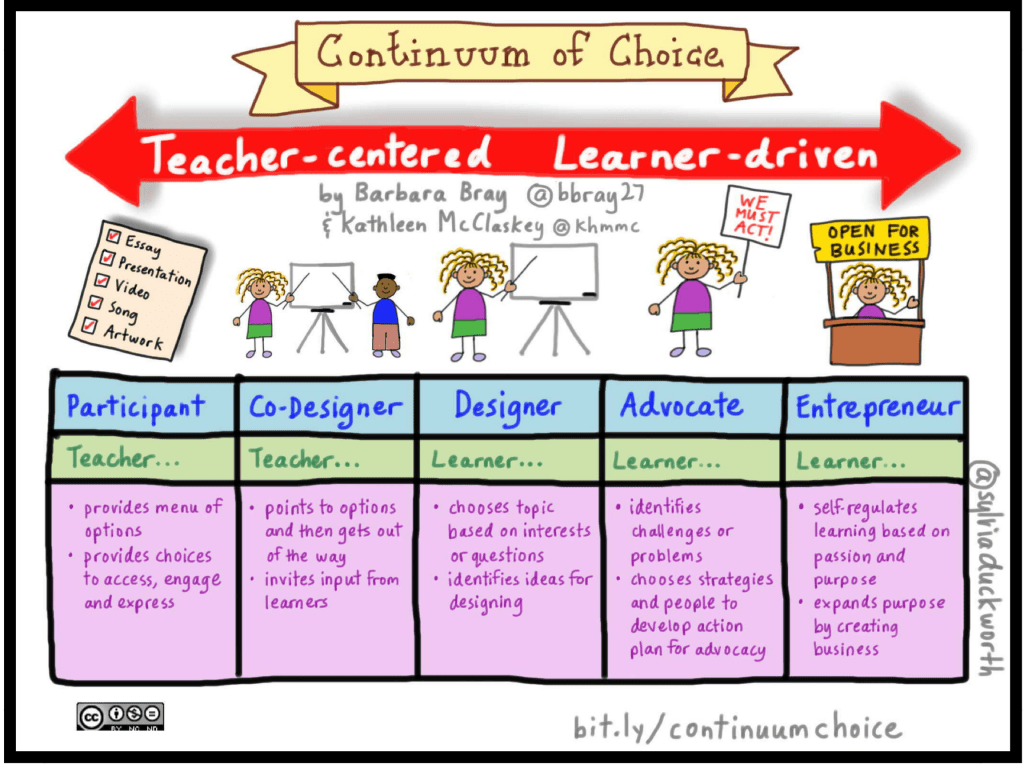
I would need to investigate which design model best fits with specific course needs as well as brainstorm what questions need to be asked in order for problem-solving to be effective. Perhaps the answer to these questions will be course-specific and may require the use different models for different activities to further promote cognitive flexibility.
References
International Society for Technology in Education, (2017). The ISTE standards for students. Retrieved from: https://www.iste.org/standards/for-students.
Kuo, F.-R., Chen, N.-S., & Hwang, G.-J. (2014). A creative thinking approach to enhancing the web-based problem solving performance of university students. Computers & Education, 72(c), 220–230.
National Academies Press. (2011). Chapter 4: Scenario-, problem-, and case-based teaching and learning. In National Academies Press, Promising practices in undergraduate science, technology, engineering, and mathematics: Summary of two workshops.(pp. 26-34.) Washington, DC. DOI: https://doi.org/10.17226/13099.
Pata, K. (2016). Problem-based learning in task-based and inquiry-based scenarios. [Blog] Retrieved from: https://creativeclassroomproject.wordpress.com/creative-classroom-collection/problem-based-learning/
